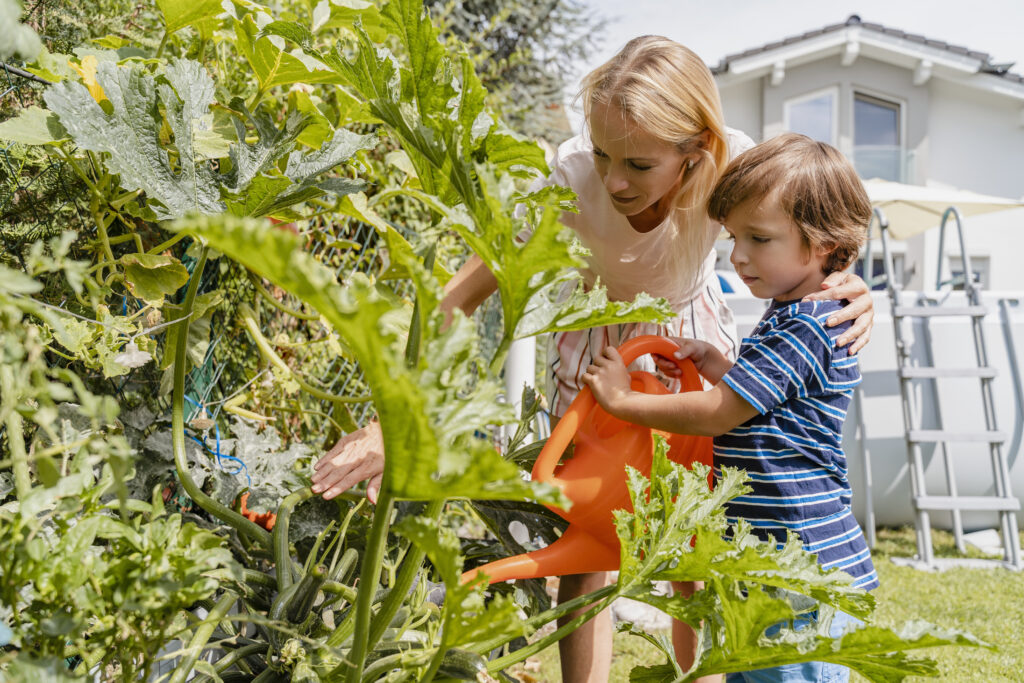Gardening with Kids: Growing Together, Learning for Life

Gardening with kids is more than just a fun outdoor activity—it’s a wonderful way to teach responsibility, patience, and the value of nurturing life. Whether you have a sprawling backyard or a small indoor space, gardening can create lasting memories while contributing to your family’s physical and emotional well-being. Let’s explore the benefits of gardening with kids, tips for getting started, and how to make gardening a year-round activity. The Benefits of Gardening with Kids Gardening provides a host of developmental and emotional benefits for children. It’s an engaging way to learn life skills while fostering parent-child bonding and encouraging hands-on learning. 1. Supports Cognitive and Emotional Development Gardening helps children develop problem-solving skills, patience, and resilience as they care for plants and observe the growth process. It’s a practical application of concepts like cause and effect, making it a great learning experience. 2. Encourages Physical Activity Digging, planting, and watering plants keep kids active and away from screens, contributing to their overall family well-being. Gardening can also be integrated into activities for toddlers, such as planting seeds or watering with a small can. 3. Promotes Healthy Eating Growing fruits, vegetables, and herbs encourages children to appreciate fresh, nutritious foods. Kids are often more willing to eat something they’ve grown themselves, fostering healthier eating habits. 4. Enhances Emotional Well-being Spending time in nature is known to reduce stress and improve mood. Gardening offers children a peaceful environment where they can connect with nature and feel a sense of accomplishment. Tips for Teaching Kids to Garden 1. Start Small Begin with easy-to-grow plants like radishes, lettuce, or herbs. These grow quickly and are less likely to frustrate young gardeners. 2. Provide Age-Appropriate Tools Give kids their own set of gardening tools that are safe and sized for their age. This makes them feel more involved and responsible. 3. Make It Fun Turn gardening into a game or challenge. For example, see who can plant seeds the fastest or grow the tallest sunflower. 4. Teach Through Play Incorporate mindful parenting by being present and engaging with your child’s curiosity. Answer their questions and share fun facts about plants, bugs, or soil. 5. Hold a Family Meeting Before starting a gardening project, hold a family meeting to plan what you’ll plant and where. This involves everyone in the decision-making process and boosts excitement. Gardening in the Yard Outdoor gardening offers a wealth of opportunities for exploration and learning. Indoor Gardening Year-Round If you don’t have outdoor space, indoor gardening is a fantastic alternative. Gardening Resources and Support For additional guidance, explore child development classes online or connect with a child development specialist to learn how gardening can support your child’s development. Access the best parenting resources to discover new gardening ideas and techniques. Stay informed by checking out our press releases here, and follow us on Instagram and YouTube for ongoing tips and creative ideas to empower your parenting journey. Final Thoughts: Growing Together Gardening with your kids is more than planting seeds—it’s about nurturing connections, fostering growth, and creating lasting memories. Whether you’re digging in the dirt together or tending to indoor plants, every moment spent gardening strengthens your bond and teaches your children the value of patience, responsibility, and care. So grab your tools, choose your seeds, and start growing something beautiful together. With every sprout, you’re not just growing plants—you’re cultivating joy, connection, and a love for the natural world that will last a lifetime.
Haircuts and Sensory Issues: A Guide to Stress-Free Grooming

For kids with Sensory Processing Disorder (SPD) or who are on the autism spectrum, getting a haircut can be an overwhelming experience. The unfamiliar sounds, textures, and environment of a salon can trigger anxiety, making what seems like a simple task a challenging ordeal. With the right strategies, tools, and support, you can make haircuts a more comfortable experience for your child. This blog explores tips to help children navigate haircuts, reviews sensory-friendly hair clippers, and offers guidance on finding salons with trained professionals who cater to kids with sensory sensitivities. Tips to Help Kids with SPD Through a Haircut 1. Prepare Them Ahead of Time Talk to your child about the haircut experience in advance. Use social stories, pictures, or videos to show them what to expect. Role-playing with dolls or stuffed animals can also help familiarize them with the process. 2. Create a Predictable Routine Children with SPD often feel more comfortable when they know what’s coming. Establish a consistent routine for haircuts, including scheduling them at the same time of day and at a familiar place. 3. Use Visual or Verbal Cues Guide your child through the process with clear, step-by-step instructions. For younger kids, activities for toddlers like drawing a picture of the haircut process can make it less intimidating. 4. Involve Them in Decision-Making Let your child choose their hairstyle or pick the tools (e.g., clippers or scissors) they prefer. This empowers them and helps reduce anxiety. 5. Sensory Tools and Comfort Items Bring along items that provide comfort, like noise-canceling headphones, a weighted lap pad, or a favorite toy. Consider playing calming music or white noise to create a soothing environment. 6. Break It Down If a full haircut feels overwhelming, consider breaking it into smaller steps, such as trimming a little each day. Celebrate each accomplishment to build their confidence. 7. Practice Mindful Parenting Stay calm and patient throughout the process. Your demeanor will set the tone and help your child feel safe. Sensory-Friendly Hair Clippers: Product Reviews Choosing the right tools can make haircuts easier at home. Here are three sensory-friendly hair clippers that are quiet, lightweight, and designed with kids in mind: 1. Wahl Easy Cut Cordless Clipper 2. Philips Norelco Kids Hair Clipper 3. Calming Clipper Finding Sensory-Friendly Hair Salons Many hair salons now offer services tailored to children with sensory sensitivities or on the autism spectrum. These salons often employ stylists trained to create a calm and accommodating environment. How to Find Sensory-Friendly Salons Additional Support and Resources For more tips and resources on supporting children with sensory issues, explore child development classes online or browse the best parenting resources. Stay updated with our press releases here, and don’t forget to follow us on Instagram and YouTube for practical advice and tools to empower your parenting journey. Final Thoughts: Transforming Haircuts into Positive Experiences Helping your child through haircuts isn’t just about grooming—it’s about building trust, fostering parent-child bonding, and showing them that their needs are understood and respected. With patience, preparation, and the right tools, you can turn haircuts into manageable, even enjoyable, experiences. Remember, every child is different, and what works for one may not work for another. Stay flexible, celebrate small victories, and know that your efforts are making a difference. Together, you and your child can navigate this journey with confidence and connection.For kids with Sensory Processing Disorder (SPD) or who are on the autism spectrum, getting a haircut can be an overwhelming experience. The unfamiliar sounds, textures, and environment of a salon can trigger anxiety, making what seems like a simple task a challenging ordeal. With the right strategies, tools, and support, you can make haircuts a more comfortable experience for your child. This blog explores tips to help children navigate haircuts, reviews sensory-friendly hair clippers, and offers guidance on finding salons with trained professionals who cater to kids with sensory sensitivities. Tips to Help Kids with SPD Through a Haircut 1. Prepare Them Ahead of Time Talk to your child about the haircut experience in advance. Use social stories, pictures, or videos to show them what to expect. Role-playing with dolls or stuffed animals can also help familiarize them with the process. 2. Create a Predictable Routine Children with SPD often feel more comfortable when they know what’s coming. Establish a consistent routine for haircuts, including scheduling them at the same time of day and at a familiar place. 3. Use Visual or Verbal Cues Guide your child through the process with clear, step-by-step instructions. For younger kids, activities for toddlers like drawing a picture of the haircut process can make it less intimidating. 4. Involve Them in Decision-Making Let your child choose their hairstyle or pick the tools (e.g., clippers or scissors) they prefer. This empowers them and helps reduce anxiety. 5. Sensory Tools and Comfort Items Bring along items that provide comfort, like noise-canceling headphones, a weighted lap pad, or a favorite toy. Consider playing calming music or white noise to create a soothing environment. 6. Break It Down If a full haircut feels overwhelming, consider breaking it into smaller steps, such as trimming a little each day. Celebrate each accomplishment to build their confidence. 7. Practice Mindful Parenting Stay calm and patient throughout the process. Your demeanor will set the tone and help your child feel safe. Sensory-Friendly Hair Clippers: Product Reviews Choosing the right tools can make haircuts easier at home. Here are three sensory-friendly hair clippers that are quiet, lightweight, and designed with kids in mind: 1. Wahl Easy Cut Cordless Clipper 2. Philips Norelco Kids Hair Clipper 3. Calming Clipper Finding Sensory-Friendly Hair Salons Many hair salons now offer services tailored to children with sensory sensitivities or on the autism spectrum. These salons often employ stylists trained to create a calm and accommodating environment. How to Find Sensory-Friendly Salons Additional Support and Resources For more tips and resources on supporting children with sensory issues, explore child development classes online or browse the best parenting resources. Stay
Affection: Building Connection and Supporting Brain Development

Affection is one of the most powerful tools in parenting. It fosters connection, builds trust, and nurtures a child’s emotional and cognitive growth. Beyond the warmth it brings, physical contact plays a crucial role in brain development, laying the foundation for healthy relationships and emotional resilience. Let’s explore why appropriate physical contact is essential, how to teach family members about affection, and ways to help children understand appropriate physical boundaries. Why the Brain Needs Physical Contact Physical affection, such as hugs, cuddles, and gentle touches, stimulates the release of oxytocin—often called the “love hormone.” This hormone reduces stress, fosters bonding, and promotes a sense of security. For children, this connection is essential for brain development, particularly in areas responsible for emotional regulation, memory, and social skills. According to child development specialists, consistent physical affection during early childhood helps children develop secure attachments, which are the foundation for healthy relationships throughout life. It also supports family well-being, creating an environment where children feel safe, loved, and valued. For younger children, incorporating affection into activities for toddlers—like holding hands during walks or sitting close while reading—reinforces these benefits naturally. Teaching Family Members About Affection Ensuring a loving and affectionate environment requires cooperation and understanding among all family members. Here are steps to encourage appropriate and meaningful displays of affection within your family: 1. Lead by Example Children often emulate the behavior they see. By practicing open and warm affection with your partner or other family members, you’re setting a powerful example. 2. Hold a Family Meeting Use a family meeting to discuss the importance of affection in strengthening bonds. This is a great opportunity to talk about different ways family members can show love, from hugs and high-fives to verbal affirmations. 3. Celebrate Cultural Differences Every family has unique ways of expressing affection, shaped by cultural or personal values. Celebrate and respect these differences while finding a shared approach that works for everyone. 4. Encourage Verbal Affection Not everyone is comfortable with physical contact, and that’s okay. Teach family members to use words to express love, such as saying, “I’m proud of you” or “I love you.” Teaching Kids Appropriate Physical Guidelines As important as affection is, teaching children about appropriate physical boundaries is equally crucial. It ensures their safety, helps them respect others, and empowers them to advocate for themselves. 1. Teach Consent Early Help your child understand that their body belongs to them and that they have the right to say no to physical contact. Similarly, teach them to respect others’ boundaries. 2. Use Role-Playing Incorporate mindful parenting by using role-playing to teach scenarios where boundaries might come into play, such as greeting someone new or comforting a friend. 3. Explain Different Kinds of Touch Discuss the difference between safe, loving touch (hugs from family) and inappropriate touch. Make it clear they can always come to you if something doesn’t feel right. 4. Provide Age-Appropriate Language For younger kids, use simple phrases like “Hugs are for family and friends who say it’s okay.” As they grow, expand the conversation to include nuanced topics about personal space and relationships. 5. Reinforce with Activities Activities like drawing personal boundaries or creating a “circle of trust” chart can make abstract concepts more tangible for children. Building a Foundation for Life Physical affection, when balanced with boundaries, fosters parent-child bonding and equips children with the emotional tools they need for a fulfilling life. Families practicing conscious co-parenting can work together to create a unified approach, ensuring consistency in messages about love and respect. For additional tips and resources, explore child development classes online or consult the best parenting resources available. Stay updated by visiting our press releases here, and follow us on Instagram and YouTube for expert advice and practical ideas that empower your parenting journey. Final Thoughts: A Loving Touch Affection is one of the simplest yet most profound ways to show love and support for your child. From cuddles on the couch to a pat on the back for a job well done, these moments create a lifetime of trust, security, and confidence. By practicing affection mindfully and teaching appropriate boundaries, you’re giving your child the tools to build healthy relationships and navigate the world with confidence. So hug often, express love freely, and let your family be a place where affection flows naturally, fostering joy and connection for generations to come.
Family Traditions: Building Bonds and Shaping Futures

Family traditions are more than just cherished memories—they’re a cornerstone of identity, connection, and emotional well-being. Whether it’s a special holiday celebration, a quirky birthday ritual, or a simple weekly routine, traditions help create a sense of belonging and security for children. These shared experiences foster parent-child bonding while also playing a vital role in shaping a child’s cognitive and emotional development. Let’s explore the value of family traditions, their impact on children’s brains, and how to establish meaningful rituals for holidays, birthdays, and everyday life. Why Family Traditions Matter Family traditions create a sense of continuity and connection. They provide children with a stable foundation in an ever-changing world, reinforcing the values and relationships that define their family. Traditions contribute to family well-being, building trust and fostering positive interactions between family members. On a neurological level, traditions stimulate the brain by reinforcing patterns and emotional connections. Celebrating milestones, engaging in rituals, or repeating familiar activities activates the reward centers of the brain, creating lasting memories. According to child development specialists, these experiences also enhance social skills, emotional intelligence, and self-esteem. Establishing New Traditions Creating family traditions doesn’t have to be elaborate or expensive. The most meaningful rituals are often simple and personal, reflecting your family’s values and interests. Holiday Traditions Birthday Traditions The Value of Legacy in Family Traditions Traditions often reflect a family’s history and cultural identity, linking generations through shared practices. They create a sense of legacy, helping children understand where they come from and what their family stands for. This connection to the past enriches their sense of self and fosters resilience. Holding a family meeting to discuss and design traditions allows everyone to contribute, ensuring that the rituals resonate with all members. These meetings also teach children the value of collaboration and active participation. The Role of Traditions in Child Development Traditions contribute significantly to a child’s growth and learning: Tips for Creating Lasting Traditions Additional Resources for Parenting Support For more tips on building family traditions and fostering mindful parenting, explore child development classes online or consult the best parenting resources available. Stay updated by visiting our press releases here, and follow us on Instagram and YouTube for ideas and inspiration. Final Thoughts: The Gift of Tradition Family traditions are a powerful way to nurture connection, teach values, and create a legacy of love and support. Whether it’s a holiday tradition that spans generations or a new ritual you create with your children, these shared moments become the fabric of your family story. So, gather your loved ones, start small, and watch as these traditions blossom into cherished memories that enrich your family’s bond for years to come. After all, the greatest gift we can give our children is the sense of belonging and joy that traditions bring.
Traveling with Kids: Pro Tips for a Smooth and Memorable Journey

Traveling with kids can feel like an adventure in itself—equal parts exciting and daunting. Whether you’re preparing for their first flight, embarking on a cruise, or planning a road trip, a little preparation goes a long way in ensuring the journey is enjoyable for everyone. Here are some practical tips to help you navigate traveling with kids, from packing smart to keeping them entertained without screens. Preparing Kids for Their First Flight Flying for the first time can be an overwhelming experience for kids. Here’s how to prepare them: Cruising with Kids: Smooth Sailing Tips Cruising can be an amazing family experience, offering a mix of adventure and relaxation. However, traveling on a ship comes with unique challenges. Travel Kits for Kids (Without Screens!) Screens can be lifesavers during long trips, but it’s good to have non-digital options that encourage creativity and engagement. Here are some ideas for screen-free travel kits: The Role of Conscious Parenting While Traveling Traveling is the perfect opportunity to practice mindful parenting. Stay present during the journey, focusing on shared experiences rather than stressing over perfection. Use the travel time to bond and strengthen your relationship with your child. Parent-child bonding happens naturally when you share in their excitement and wonder, whether it’s spotting the first cloud from the plane window or exploring new cultures together. For parents sharing responsibilities, conscious co-parenting is essential. Collaborate to divide tasks like packing, navigating, and keeping the kids entertained. This ensures a smoother trip and sets an example of teamwork for your children. Tips for Stress-Free Travel Stay Connected for More Tips For additional parenting tips, travel ideas, and expert advice, follow us on Instagram and YouTube. We share resources designed to empower your parenting journey and make family adventures unforgettable. To stay informed on family travel trends, check out our press releases here for the latest updates. Final Thoughts: Embrace the Adventure Traveling with kids is less about perfection and more about creating memories together. With preparation, flexibility, and a little creativity, family trips can be a source of joy and connection. Whether it’s your child’s first flight or a family cruise, these shared experiences will strengthen your bond and leave you with stories to cherish for a lifetime. So pack your bags, embrace the adventure, and remember: even the challenges become part of the journey. Happy travels!
Sleep Training: Navigating the Journey to Restful Nights

Sleep training is a hot topic for parents, often stirring a mix of emotions. Whether you’re considering letting your child “cry it out,” co-sleeping, or finding a middle ground, the ultimate goal remains the same: ensuring both you and your child get the rest needed for family well-being. Let’s explore the pros and cons of sleep training, why sleep is crucial for your little one’s development, and how to navigate this journey with care and compassion. Why Sleep Matters Sleep is essential for a child’s physical and mental development. During sleep, their brain consolidates learning, processes emotions, and supports growth. A lack of quality sleep can lead to irritability, difficulty concentrating, and even developmental delays. For parents, insufficient sleep can strain relationships, lower patience levels, and impact your ability to fully engage in parent-child bonding. Sleep training is one way to establish healthy sleep habits, promoting better nights for everyone. Pros and Cons of Sleep Training Sleep training isn’t a one-size-fits-all solution. Understanding its advantages and potential challenges can help you decide what’s best for your family. Pros of Sleep Training Cons of Sleep Training Methods of Sleep Training Cry It Out (CIO) This method involves letting your child cry for gradually increasing periods before comforting them. The idea is to teach self-soothing skills. Gradual Extinction This approach involves slowly reducing your intervention during bedtime over several nights, helping your child adjust at their own pace. Co-Sleeping Co-sleeping involves sharing a bed or room with your child, offering immediate comfort and reassurance. Caring for Your Child During Sleep Training Whether you choose CIO, gradual extinction, or co-sleeping, it’s important to approach sleep training with empathy and mindful parenting techniques. Balancing Parental Roles with Conscious Co-Parenting Sleep practice is easier with teamwork. Practicing conscious co-parenting allows both parents to share the responsibility, ensuring no one feels overwhelmed. Discuss your approach together during a family meeting, and create a plan that works for everyone. Tips for a Smoother Sleep Training Journey Additional Resources for Parents Parenting is a journey filled with learning curves, and sleep training is no exception. Explore child development classes online and access the best parenting resources for tips, tools, and insights that support your child’s growth. For updates on parenting trends and expert advice, check out our press releases here, and follow us on Instagram and YouTube for ongoing tips that empower your parenting journey. Final Thoughts: Restful Nights for a Thriving Family Sleep training is about finding what works best for your child and your family. Whether you let them “cry it out,” co-sleep, or blend methods, the goal is to establish healthy sleep habits that benefit everyone. Trust your instincts, stay patient, and remember that every family’s journey is unique. Ultimately, restful nights pave the way for happier, healthier days, allowing you and your child to thrive together. Sweet dreams!
School Choice: Finding the Best Fit for Your Child

Choosing the right educational path for your child is one of the most significant decisions you’ll make as a parent. Whether you’re considering homeschooling, public school, or private school, each option comes with its own benefits and challenges. The key is finding the choice that aligns with your child’s needs, your family’s values, and your long-term goals. Here’s a guide to help you make an informed decision, with considerations for each school type and practical tips for navigating this important choice. Homeschooling: A Personalized Learning Experience Homeschooling offers a tailored approach to education, allowing parents to design a curriculum that suits their child’s unique learning style and pace. This option is particularly appealing for families who want to prioritize mindful parenting, as it provides opportunities to integrate activities for toddlers and older children into daily learning. Pros: Cons: If homeschooling appeals to you, consider consulting a child development specialist to ensure your curriculum supports your child’s developmental milestones. Public School: A Structured and Social Environment Public schools are a popular choice for many families due to accessibility and the opportunity for children to interact with peers in a structured environment. Schools often have established resources, extracurricular activities, and trained educators who support various learning needs. Pros: Cons: Parents practicing conscious parenting can stay involved by attending school events, communicating with teachers, and creating a supportive home environment for learning. Private School: Specialized and Value-Aligned Education Private schools offer smaller class sizes, specialized programs, and often align with specific educational philosophies or religious values. They can be an excellent choice for families seeking a focused approach to their child’s education. Pros: Cons: Before committing, visit the school, meet the teachers, and attend open houses to ensure the environment aligns with your family’s expectations and your child’s personality. Factors to Consider When Choosing a School When evaluating school options, it’s essential to consider both your child’s needs and your family’s circumstances. Here are a few factors to keep in mind: Consider holding a family meeting to discuss these factors together, allowing older children to share their thoughts. This collaborative approach fosters family well-being and ensures everyone feels involved in the decision. Supporting Your Choice with Resources Whichever path you choose, supplementing your child’s education with child development classes online or exploring the best parenting resources can help fill any gaps and enhance their learning experience. These tools provide parents with valuable insights and strategies for supporting their child’s growth. For updates on educational trends and insights, check out our press releases here to stay informed about the latest in child development and schooling options. Final Thoughts: Choosing with Confidence Choosing a school is a deeply personal decision, and there’s no one-size-fits-all answer. By understanding your child’s needs, exploring your options, and staying involved in their education, you can create a supportive and enriching environment for their development. For more tips and guidance on parenting and education, follow us on Instagram and YouTube. We share valuable insights, resources, and tools to empower your parenting journey and help you make confident decisions for your child’s future. Remember, the ultimate goal is to provide an environment where your child feels supported, challenged, and inspired to grow. Trust your instincts, stay flexible, and know that your thoughtful choice will set the foundation for your child’s success and happiness.
Safe Halloween: Protecting Your Children While Keeping the Fun

Halloween is an exciting time for children and families. Costumes, candy, and community celebrations make it a holiday to remember. However, with strangers, alcohol at parties, and distracted parents in the mix, ensuring your child’s safety becomes a top priority. By planning ahead and practicing mindful parenting, you can create a memorable and safe Halloween for everyone. Planning for a Safe Halloween Preparation is key to a safe and enjoyable Halloween. Here are steps to take before heading out for trick-or-treating or attending any celebrations: 1. Choose Safe Costumes Costumes should be fun but also practical. Here’s what to keep in mind: 2. Map Out Your Route If you’re trick-or-treating, plan your route in advance. Stick to well-lit areas and neighborhoods you’re familiar with. This minimizes the risk of encountering unsafe environments. 3. Discuss Safety Rules Before heading out, hold a family meeting to go over basic safety rules. Topics to cover: Tips for Safe Trick-or-Treating 1. Go as a Group There’s safety in numbers. Whether you’re walking as a family or with friends, traveling in a group reduces risks and ensures kids are less likely to wander off. 2. Stay Visible Equip your child with a flashlight or glow-in-the-dark accessories. These not only make them easier to spot but also add a fun element to their costume. 3. Check Candy Carefully Before allowing your child to dig into their candy haul, inspect it for tampering. Discard anything that looks opened, unusual, or homemade (unless from someone you trust). Attending Halloween Parties Halloween parties can be fun for older children and families, but they also come with potential hazards, such as alcohol and crowded spaces. Here’s how to keep it safe: 1. Supervise Younger Kids Keep an eye on young children, especially if the party has open alcohol or other distractions. Conscious parenting helps you stay present and aware of your child’s surroundings. 2. Monitor Food and Drinks Make sure your child sticks to food and drinks you’ve approved. It’s easy for little ones to grab something inappropriate in the excitement of a party. 3. Encourage Respectful Behavior Parties often include interactions with unfamiliar people. Teach your child to be polite but cautious, reinforcing boundaries and personal space. Safe Fun at Home If trick-or-treating or parties aren’t your style, consider hosting a Halloween celebration at home. This option allows for creative, safe fun. Ideas for a Home Halloween Party: These activities foster family well-being while keeping the excitement of Halloween alive. Additional Safety Tips for Parents Resources for Parenting Support For more insights on safety, parenting, and child development, check out the best parenting resources available on our website. You can also find helpful advice through child development classes online or by consulting a child development specialist. Stay updated on the latest trends and safety tips by visiting our press releases here, and follow us on Instagram and YouTube for ongoing tips that will empower your parenting journey. Final Thoughts: A Halloween to Remember Halloween is a magical time for kids, filled with fun and adventure. By taking proactive steps to ensure their safety, you can focus on creating memories that last a lifetime. Whether it’s planning your route, choosing the perfect costume, or holding a family meeting to go over safety rules, each effort contributes to a joyful and secure experience. This Halloween, embrace the excitement, practice safety, and enjoy the holiday with your little ones. After all, the most important treat is the peace of mind that comes from knowing your family is safe and happy. Have a spooky, safe, and spectacular Halloween! 🎃
Potty Training: Navigating the Journey with Patience and Positivity

Potty training is a milestone every parent looks forward to, but it’s also one that comes with its share of challenges. It’s easy to worry about timelines or feel frustrated when progress is slow, but here’s the good news: your child won’t go to college in a pull-up. Each child has their unique timeline, and with the right approach, you can make this process a positive experience for the entire family. Let’s explore popular potty training methods, how to stay patient, and how to make the journey as smooth as possible. Why Potty Training Matters Beyond the practical benefits of ditching diapers, potty training plays a significant role in a child’s development. It’s an opportunity to teach independence, responsibility, and self-awareness. For parents, it’s also a moment to practice mindful parenting, where you stay present and attuned to your child’s needs and emotions. Potty training can also enhance parent-child bonding as you work together toward a shared goal. With patience and a bit of creativity, this process can become an empowering experience for your child. The 3-Day Potty Training Method: A Quick Transition The 3-day method is a popular approach for parents looking to make a quick transition from diapers to potty. It involves dedicating three days to intensive potty training, where your child goes diaper-free and is encouraged to use the potty consistently. Benefits of the 3-Day Method: Tips for Success: The Benefits of Pull-Ups For families who prefer a gradual approach, pull-ups can be an excellent tool. They provide a middle ground between diapers and underwear, helping your child transition at their own pace. Benefits of Pull-Ups: Pull-ups can be particularly helpful during the early stages of potty training or as part of a conscious co-parenting strategy, ensuring consistency between caregivers. The Power of the Reward System Rewards can be a fun and effective way to motivate your child during potty training. The key is to make rewards immediate and achievable to reinforce positive behavior. Reward Ideas: Using rewards ties into family well-being by creating a positive atmosphere around potty training, making it a less stressful experience for both you and your child. Staying Positive Throughout the Process Potty training is a journey, not a race. Here’s how to stay positive even when it feels challenging: Additional Resources for Support Potty training doesn’t have to be overwhelming. There are plenty of resources available to guide you through the process. Explore child development classes online or check out the best parenting resources to gain tips and techniques from experts. For updates and insights, visit our press releases here, and follow us on Instagram and YouTube for ongoing tips, tools, and advice to empower your parenting journey. Final Thoughts: Trust the Process Potty training is a significant milestone, but it’s also just one of many steps in your child’s growth. By staying patient, supportive, and positive, you’re not only teaching them a skill—they’re also learning resilience, independence, and trust in your guidance. Whether you opt for the 3-day method, pull-ups, or a blend of both, remember that every child progresses at their own pace. Embrace the journey, celebrate the milestones, and know that with love and encouragement, you’re setting your child up for success—both in potty training and beyond. Happy training!
Birth Order and Personality: Understanding Your Child’s Unique Traits

Birth order has long been a topic of fascination among parents and psychologists alike. It’s believed that a child’s position within the family—whether they’re the firstborn, middle child, or youngest—can influence their personality, behavior, and even the dynamics of their relationships. While every child is unique, understanding the general patterns associated with birth order can help parents foster stronger connections and create a harmonious family environment. Firstborn: The Responsible Leader Firstborn children often take on the role of the leader within the family. As the eldest, they tend to be more responsible, organized, and achievement-oriented. Parents often place higher expectations on firstborns, which can lead to traits like perfectionism and a strong drive for success. These children may also develop nurturing tendencies, stepping into a “mini-parent” role for their younger siblings. Key Traits of Firstborns: Parenting Tip: Encourage firstborns to relax and enjoy activities that allow them to unwind, such as activities for toddlers if they’re young or hobbies that don’t involve competition. Ensure they know it’s okay to make mistakes and prioritize fun alongside responsibility. Middle Child: The Diplomatic Peacemaker Middle children often find themselves in the role of mediator, balancing relationships between their older and younger siblings. They tend to be adaptable, social, and empathetic, as they’ve grown up navigating family dynamics. Middle children may seek their own identity outside of their siblings, often pursuing unique interests or friendships. Key Traits of Middle Children: Parenting Tip: During a family meeting, give middle children the opportunity to share their thoughts and feelings. This helps them feel valued and ensures their voice isn’t lost in the shuffle. Celebrate their unique interests to reinforce their individuality. Youngest Child: The Free-Spirited Charmer The youngest child often takes on the role of the family’s entertainer or free spirit. With older siblings to pave the way, the youngest tends to enjoy a more relaxed set of expectations. They’re often charming, creative, and adventurous but may also rely on others for support or decision-making. Key Traits of Youngest Children: Parenting Tip: While fostering the youngest child’s creativity, provide structure and encourage independence. Balancing freedom with responsibility ensures they grow into confident, capable individuals. How Birth Order Impacts Family Dynamics Understanding birth order can help parents create a harmonious family environment by recognizing and addressing the unique needs of each child. This aligns with mindful parenting, which encourages being present and attuned to your children’s emotional and developmental cues. Conscious co-parenting can also play a significant role in balancing dynamics. By collaborating on how to address each child’s individual needs, parents can reduce sibling rivalry and ensure that every child feels equally loved and supported. Tips for Navigating Birth Order Dynamics Stay Informed and Connected For more tips and insights on parenting strategies and child development, follow us on Instagram and YouTube. We share expert advice, practical tools, and real-life stories to empower your parenting journey. To stay updated on the latest research and resources, check out our press releases here for the most recent information on family dynamics and child behavior. Final Thoughts: Embracing the Unique Traits of Each Child Birth order provides a fascinating lens through which to view your children’s personalities, but it’s only one piece of the puzzle. By understanding their unique traits and tailoring your approach, you can nurture their growth, foster stronger relationships, and create a family environment where everyone thrives. Celebrate your firstborn’s leadership, your middle child’s diplomacy, and your youngest’s creativity. Together, these qualities make your family dynamic rich and special. Parenting is a journey, and with a little insight and intentionality, you can guide your children to become the best versions of themselves.

